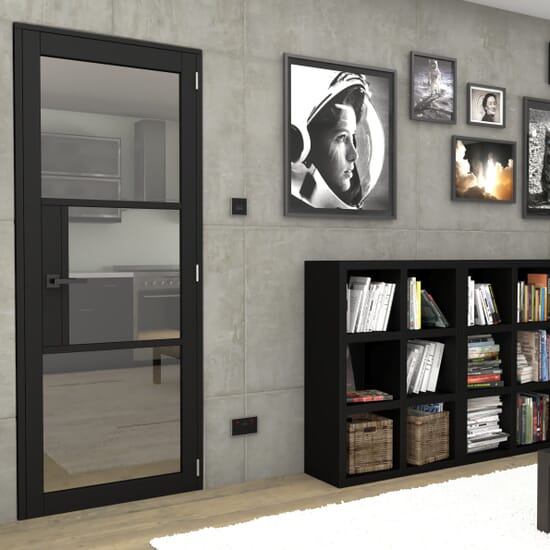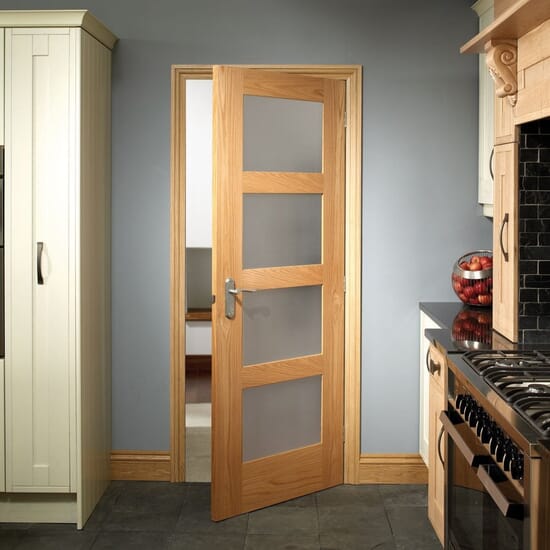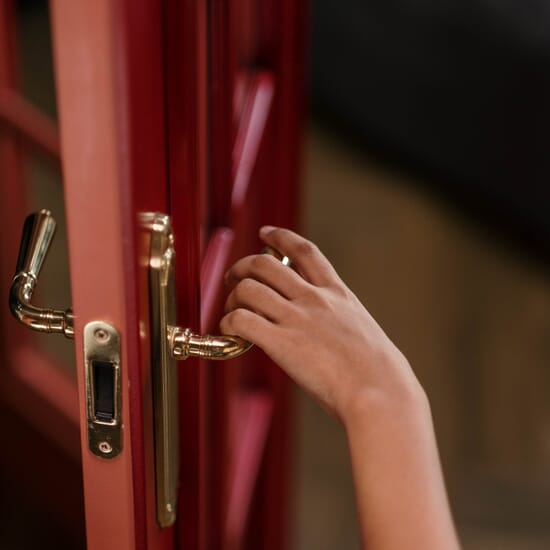What You’ll Need
- A Lightweight Hammer and a rubber mallet
- A Cordless drill
- A Ladder
Time Required: This is a relatively small job, and it can usually be completed in an hour.
Fitting Internal Bifold Doors
The main process of fitting internal bifold doors is actually quite easy. Often, the hardest part is fitting the hardware for the door. The actual fitting of the door into the opening simply requires following some step-by-step instructions:
- There should be two holes on the top end of the door. One hole should be at the ‘hinge end’, which is the end that sits closest to the door frame.
- Once you have found the end hole, you should put the hinge pin into it. The bi-fold door should come with three pins, one smooth metal pin, one roller pin, and one metal, ridged pin. The smooth pin is the one that you want to use first. Push the pin into the hole, and tap it into place lightly with a hammer.
- Next, push the roller pin into the other hole. The roller pin will go into the guide, so this is the side of the door that will be sliding in the guide.
- Lightly hammer the roller pin into the hole. Take care when doing this, because the roller is plastic and could break easily. Use a rubber mallet if possible to reduce the risk of this happening.
- Lay the door on the floor and locate the hinge end. There will be a hole there. Insert the ridged pin into that hole, and use a hammer to tap the pin into place.
- Now it’s time to fit the guides to the door frame. Make sure that you fit the guide the correct way around. You want the metal hinge-rest to be located closest to the side of the door frame. Make some small guide holes with your drill, and then screw the hinge rest into place.
- Next, fit the L-shaped bracket to the bottom of the door frame, near the floor. There are three screw holes here – two that go into the door frame, and one that goes into the floor. The floor screw is optional, so if you don’t want to damage expensive flooring, you don’t have to use it, but it’s a good idea to fit it to give the door maximum stability. The part of the bracket with ‘teeth’ on the slit should go across the floor, while the other part goes against the door frame.
- Now fit the end spring to the top of the frame, inside the metal guide. You should see that there’s a clip at the end of the guide, in the part farthest away from the hinge end of the door, where you can put the spring. Just push the spring into place with your hands. It should fit easily. Don’t use tools to put it into place, because the spring could be damaged quite easily.
- Finally, put the door into the frame. Start with the smooth pin, which goes into the top guide,
then put the ridged pin into the L-shaped bracket. This part should be quite easy; the door should just swing into place. - Once you have those two pins in place, you will need to get the roller pin into the metal guide. You’ll probably need to get onto a ladder to do this, and it might take some (controlled) force. Sometimes this is easier if you have a second person with you to stabilise the door, but it is possible to do it alone if you are careful.
If you really want to put your own stamp on your internal bifold doors, we even have a handy DIY guide to painting internal bifold doors.
Check out our full internal bifold doors, with so many styles there's bound to find a style that suits your home. If you need any extra help deciding, you can check out our FAQs to see if your query has already been asked or get in touch with us.
In Summary
Fitting bi-fold doors is not a hard job. There are a few things that you can do to make it easier. If you have sawhorses to balance the door on, for example, then that will be easier than working on the floor. Having a friend with you to hold the door steady is another option – but this is a job that you can do alone in an hour or so.
This guide assumes that the door you purchased was a finished door. If it was an unfinished, or merely pre-finished door, then be sure to paint it before you hang it. Painting the door in place is awkward and is likely to lead to a bad finish.
Some folding doors have hinges on one side, and then an ‘arm’ that allows the door to fold when it opens and closes. Fitting this type of door follows a similar process – fit the guide rails, mark out where the hinges will go, drill holes for the hinges and then screw them into place, and then fit the door – hinges first, then the arm. If you’re fitting this type of door, it’s important to rehang the doors regularly throughout the process and check that they move freely.
Test the control arm in particular. The ideal length for the control arm is usually around a quarter of an inch less than the width of one of the folding doors, but it’s worth testing it to make sure that the door doesn’t feel too heavy, and that it opens and closes smoothly. Make sure that the opening is plumb before you start work, and remember that if there are minor alignment problems they can usually be fixed by adjusting the hinges slightly.
Check out our full range of internal doors, as well as many wonderful patio doors and external bifold doors which can really transform a space. We've got wide selections of top-quality products at great prices on our website. Don't hesitate to get in touch if you have any questions or head to our FAQs to see if your query has already been answered!







